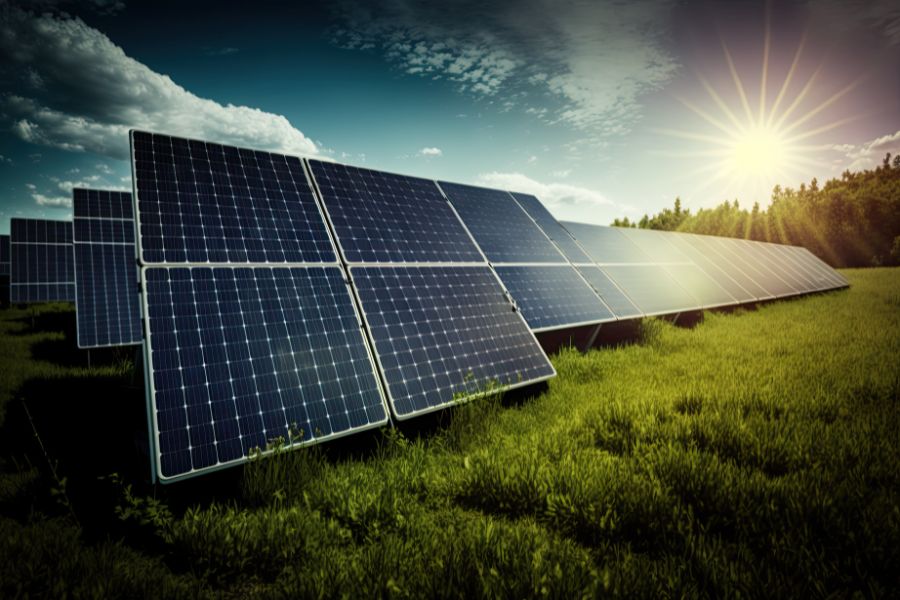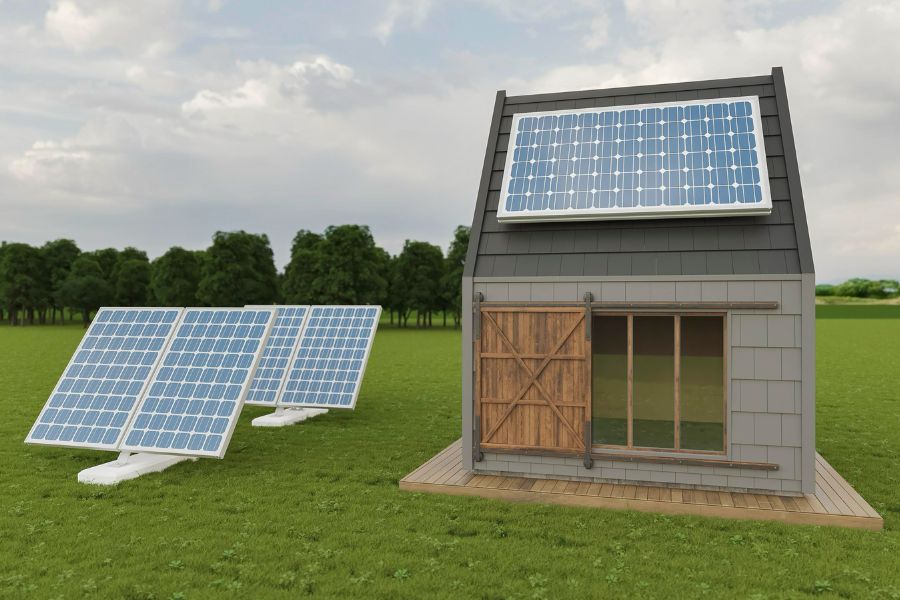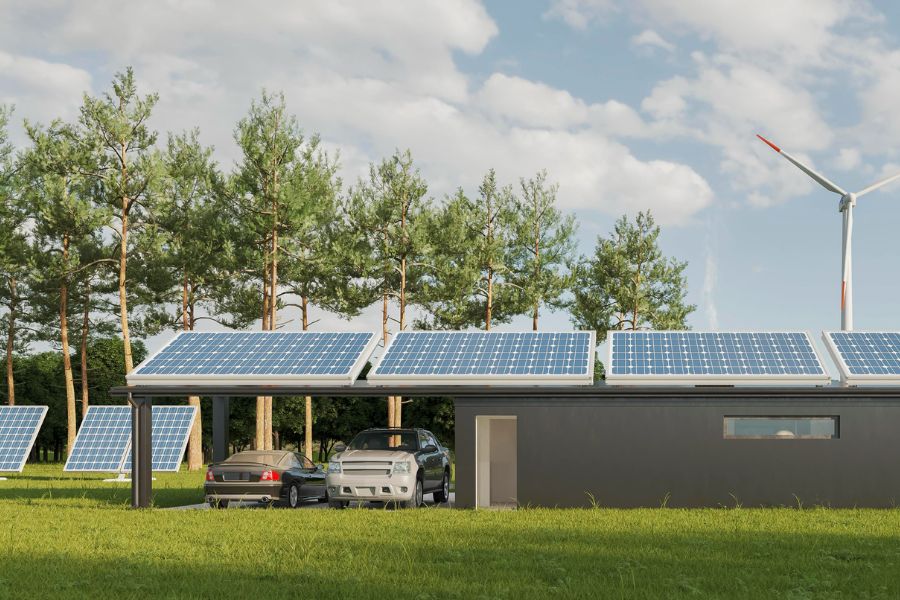Al Butain is a service provider of comprehensive solar energy solutions, specializing in the design, engineering, procurement, and construction (EPC) of solar power projects across India and the Middle East. With a commitment to driving the transition to clean and renewable energy, we deliver high-quality solar projects for utility-scale installations, commercial rooftops, residential applications, and off-grid solutions.
We offer end-to-end solar project solutions that cater to diverse client needs, from large-scale solar farms to distributed generation systems. Our area of expertise includes ON-Grid, OFF-Grid & Hybrid Solar PV Power Plants.
Our expertise encompasses every stage of the project lifecycle, ensuring seamless execution and optimal performance.

ON-GRID SOLAR SYSTEM
Al butain is a service provider of comprehensive solar energy solutions, specializing in the design, engineering, procurement, and construction (EPC) of solar power projects across India and the Middle East. With a commitment to driving the transition to clean and renewable energy, we deliver high-quality solar projects for utility-scale installations, commercial rooftops, residential applications, and off-grid solutions. We offer end-to-end solar project solutions that cater to diverse client needs, from large-scale solar farms to distributed generation systems. Our area of expertise includes ON-Grid, OFF-Grid & Hybrid Solar PV Power Plants. Our expertise encompasses every stage of the project lifecycle, ensuring seamless execution and optimal performance.
Introducing Core Values
Project Development and Feasibility Analysis
Comprehensive site assessment, solar resource analysis, and feasibility studies to determine the technical, economic, and environmental viability of solar projects.
Engineering, Procurement, and Construction (EPC)
Turnkey EPC services, including system design, detailed engineering, procurement of high-quality solar components, installation, commissioning, and grid integration.
Solar Energy Storage Solutions
Integration of energy storage systems, such as lithium-ion batteries, with solar PV plants to provide uninterrupted power supply, grid stability, and peak load management.
Solar Power Plant Solutions
Utility-Scale Solar Farms: Design and construction of large-scale solar farms with advanced technologies such as single-axis and dual-axis tracking systems to maximize energy yield.
Rooftop Solar Solutions: Tailored solar rooftop installations for commercial, industrial, and residential sectors to reduce energy costs and promote sustainability.
Hybrid and Off-Grid Solar Systems: Customized hybrid solutions combining solar power with battery storage, diesel generators, or other renewable energy sources to ensure reliable power supply in remote and off-grid locations.
Solar Product Trading
Supply and distribution of high-quality solar components, including solar panels, inverters, batteries, mounting structures, and balance of system (BOS) components, ensuring cost-effective and reliable solutions for diverse project requirements.

Our Commitment to a Greener Future
At Al Butain, we believe in a future powered by clean and renewable energy. Our mission is to provide efficient, reliable, and sustainable solar energy solutions that help our clients achieve their energy goals while contributing to a greener planet. With a client-centric approach, innovative solutions, and a strong focus on quality, we are your trusted partner in the solar energy sector.
COMMON TYPES OF SOLAR SYSTEMS

ON-GRID SOLAR SYSTEM
An on-grid solar system, also known as a grid-tied solar system, is a popular choice for homes and businesses looking to harness solar energy. This type of system is connected to the public electricity grid and is designed to work in tandem with the utility grid, offering several advantages and functionalities. Below, we provide an indepth look at the components, benefits, and operation of an on-grid solar system.
Key Components of an On-Grid Solar System
Solar Panels
These are the primary components that convert sunlight into direct current (DC) electricity. Solar panels are typically installed on rooftops or in open areas with maximum sun exposure.
Metering System
This includes a bi-directional meter that tracks the amount of electricity fed into the grid and the amount drawn from the grid. Net metering is a common mechanism that allows users to receive credits for the surplus electricity they generate.
Inverter
The inverter is a crucial component that converts the DC electricity generated by the solar panels into alternating current (AC) electricity, which can be used by household appliances or fed into the grid
Mounting System
This includes racks and mounting hardware to secure the solar panels to roofs or ground installations.
Grid Connection:
Supply and distribution of high-quality solar components, including solar panels, inverters, batteries, mounting structures, and balance of system (BOS) components, ensuring cost-effective and reliable solutions for diverse project requirements.
Electrical Wiring and Components
These ensure the safe transmission of electricity from the solar panels to the inverter and then to the household or grid.
How On-Grid Solar Systems Work
Solar Energy Generation
During the day, solar panels absorb sunlight and convert it into DC electricity.
Grid Interaction:
At night or during periods of low sunlight, the system draws electricity from the grid to meet household energy needs.
Inversion Process
The DC electricity is sent to the inverter, which converts it to AC electricity suitable for use in homes and businesses
Net Metering
Through net metering, users can receive credits for the excess electricity they generate. These credits can offset the cost of the electricity drawn from the grid.
Electricity Usage:
The AC electricity is used to power household appliances and devices. If the solar system generates more electricity than needed, the excess is fed into the utility grid.
Benefits of On-Grid Solar Systems
Cost Savings
On-grid systems can significantly reduce electricity bills by generating a portion of the energy needed and feeding surplus energy back to the grid.
Scalability
On-grid systems can be easily expanded by adding more panels and inverters to meet increasing energy demands.
Energy Credits
With net metering, users earn credits for excess energy, which can further offset costs during times when the system is not producing enough power
Reliability
Being connected to the grid ensures a constant power supply, even when the solar system is not generating electricity.
No Battery Storage Required:
Unlike off-grid systems, on-grid systems do not require expensive battery storage solutions, reducing the initial investment cost.
Considerations for On-Grid Solar Systems
Initial Investment
The upfront cost for solar panels, inverters, and installation can be significant, but it is often offset by long-term savings and incentives.
Permitting and Regulations
Installation requires adherence to local building codes and regulations, and securing necessary permits can be time-consuming.
Grid Dependency
On-grid systems do not provide power during grid outages unless coupled with battery storage or a backup generator.
Net Metering Policies
These vary by location and can impact the financial benefits of the system. It is important to understand local policies before installation.
Why Choose Us for On-Grid Solar System
We specialize in designing, installing, and maintaining high-quality on-grid solar systems. Our team of experts will guide you through every step of the process, from initial consultation to final installation and beyond. We are committed to helping you achieve energy independence and reduce your carbon footprint.

OFF-GRID SOLAR SYSTEM
An off-grid solar system, also known as a standalone solar system, is designed to operate independently of the public electricity grid. This type of system is ideal for remote areas where access to the grid is unavailable or for individuals who prefer complete energy independence. Below, we provide an in-depth look at the components, benefits, and operation of an off-grid solar system.
Key Components of an Off-Grid Solar System
Solar Panels
These convert sunlight into direct current (DC) electricity. Solar panels are typically installed on rooftops or in open areas with maximum sun exposure.
Backup Generator
In some systems, a generator is included to provide additional power during prolonged periods of low sunlight or high energy demand.
Battery Bank
A crucial component that stores the DC electricity generated by the solar panels for use when the sun is not shining, such as during nighttime or cloudy days
Mounting System
Includes racks and mounting hardware to secure the solar panels to roofs or ground installations.
Charge Controller
This device regulates the voltage and current coming from the solar panels to the batteries, preventing overcharging and extending battery life.
Electrical Wiring and Components
Ensure the safe transmission of electricity from the solar panels to the charge controller, batteries, inverter, and household.
Inverter
Converts the stored DC electricity from the batteries into alternating current (AC) electricity, which can be used by household appliances.
How Off-Grid Solar Systems Work
Solar Energy Generation
During the day, solar panels absorb sunlight and convert it into DC electricity.
Power Conversion
The inverter converts the stored DC electricity from the batteries into AC electricity, making it usable for household appliances and devices
Battery Charging
The generated DC electricity is directed to the charge controller, which regulates the power flow to charge the battery bank efficiently.
Backup Power
If the batteries run low, a backup generator can provide additional power, ensuring a continuous energy supply.
Energy Storage
The batteries store the DC electricity for use when the solar panels are not producing power, such as at night or during cloudy weather.
Benefits of Off-Grid Solar Systems
Energy Independence
Off-grid systems allow you to be completely self-sufficient, not relying on the public electricity grid.
Environmental Impact
Reduces reliance on fossil fuels and decreases your carbon footprint by generating clean, renewable energy.
Remote Viability
Ideal for remote locations where connecting to the grid is impractical or too expensive.
Resilience
Provides power during grid outages and natural disasters, ensuring a reliable energy supply at all times.
Considerations for Off-Grid Solar Systems
Initial Investment
Off-grid systems typically have a higher upfront cost due to the need for batteries and possibly a backup generator.
Maintenance
Batteries and generators require regular maintenance to ensure optimal performance and longevity.
System Sizing
Accurate sizing is crucial to ensure the system meets your energy needs without running out of power. This involves a thorough assessment of energy consumption patterns.
Energy Management
Users must be mindful of their energy consumption, especially during periods of low solar production, to avoid depleting the batteries.
Why Choose Us for Off-Grid Solar System
We specialize in designing, installing, and maintaining high-quality off-grid solar systems tailored to your specific needs. Our team of experts will guide you through every step of the process, from initial consultation to final installation and beyond. We are committed to helping you achieve energy independence and sustainability.

HYBRID SOLAR SYSTEM
A hybrid solar system combines the best features of both on-grid and off-grid solar systems. It is connected to the public electricity grid and includes a battery storage system, allowing you to store excess energy generated by the solar panels for use during nighttime or power outages. This type of system offers flexibility, energy independence, and reliability. Below, we provide an in-depth look at the components, benefits, and operation of a hybrid solar system.
Key Components of an Hybrid Solar System
Solar Panels
These convert sunlight into direct current (DC) electricity. Solar panels are typically installed on rooftops or in open areas with maximum sun exposure
Grid Connection
The system is connected to the local utility grid, allowing for the import of electricity when solar and battery power are insufficient and the export of excess solar power.
Battery Bank
Stores the DC electricity generated by the solar panels for use when solar energy production is low or during power outages.
Hybrid Inverter
An advanced inverter that manages the flow of energy between the solar panels, battery bank, and the grid, ensuring efficient energy use and storage.
Charge Controller
Regulates the voltage and current coming from the solar panels to the batteries, preventing overcharging and extending battery life.
Mounting System
Includes racks and mounting hardware to secure the solar panels to roofs or ground installations.
Inverter
Converts the stored DC electricity from the batteries into alternating current (AC) electricity, which can be used by household appliances. It also converts solar-generated DC power to AC power for immediate use or grid export.
Electrical Wiring and Components
Ensure the safe transmission of electricity from the solar panels to the charge controller, batteries, inverter, and household.
How Hybrid Solar Systems Work
Solar Energy Generation
During the day, solar panels absorb sunlight and convert it into DC electricity.
Grid Interaction
When the solar panels produce more electricity than needed and the batteries are fully charged, the excess electricity is exported to the grid. During periods of low solar production, the system can draw power from the grid if the batteries are depleted.
Battery Charging
The generated DC electricity is directed to the charge controller, which regulates the power flow to charge the battery bank efficiently.
Power Usager
The inverter converts the DC electricity to AC electricity for immediate use by household appliances. Any excess electricity generated is used to charge the batteries.
Backup Power
In the event of a power outage, the battery bank provides a backup power supply, ensuring continuous electricity for essential appliances.
Benefits of Hybrid Solar Systems
Energy Independence
Hybrid systems allow you to generate and store your own energy, reducing reliance on the grid and providing backup power during outages.
Flexibility
Hybrid systems offer the flexibility to adjust between using solar power, stored energy, and grid power, optimizing energy use and cost efficiency.
Reliability
Enjoy a reliable power supply even during grid outages or periods of low solar production, thanks to the battery backup.
Cost Savings
Reduce electricity bills by generating your own power and using stored energy during peak rate periods. Net metering can provide additional savings by compensating for the excess power fed back to the grid.
Environmental Impact
Reduce your carbon footprint by using clean, renewable energy and decreasing reliance on fossil fuels.
Considerations for Hybrid Solar Systems
Initial Investment
Hybrid systems typically have a higher upfront cost due to the inclusion of batteries and advanced inverters, but they offer long-term savings and benefits.
Maintenance
Batteries and inverters require regular maintenance to ensure optimal performance and longevity.
System Sizing
Proper system sizing is crucial to ensure the system meets your energy needs and optimally balances generation, storage, and consumption.
Energy Management
Effective energy management is essential to maximize the benefits of a hybrid system, including monitoring energy production, storage, and consumption.
Why Choose Us for Hybrid Solar System
We specialize in designing, installing, and maintaining high-quality hybrid solar systems tailored to your specific needs. Our team of experts will guide you through every step of the process, from initial consultation to final installation and beyond. We are committed to helping you achieve energy independence, cost savings, and sustainability.
ROOFTOP SOLAR SYSTEMS
Rooftop solar systems are solar power installations mounted on the roof of residential, commercial, or industrial buildings. They are a popular choice due to their efficient use of space and their ability to directly supply electricity to the building below.
Key Components of Rooftop Solar Systems
Solar Panels
Installed on the roof to convert sunlight into direct current (DC) electricity.
Electrical Wiring and Components
Connect the panels to the inverter and the building’s electrical system.
Inverter
Converts the DC electricity generated by the panels into alternating current (AC) electricity, suitable for use in homes and businesses.
Net Metering (for on-grid systems)
A bi-directional meter tracks electricity usage and the amount fed back into the grid.
Mounting System
Racks and mounts secure the solar panels to the roof, designed to withstand various weather conditions.
Benefits of Rooftop Solar Systems
Space Efficiency
Utilizes existing roof space, making it ideal for urban areas where land is limited.
Environmental Impact
Reduces carbon footprint by generating clean energy.
Cost Savings
Reduces electricity bills and can generate additional savings through net metering.
Increased Property Value
Often increases the value of the property due to reduced utility costs and environmental benefits.
Energy Independence
Provides a reliable source of renewable energy.
Considerations for Rooftop Solar Systems
Roof Condition
The roof must be in good condition and able to support the weight of the solar panels.
Permitting and Regulations
Compliance with local building codes and regulations is required.
Sunlight Exposure
Adequate sunlight exposure is essential for optimal performance.
Maintenance
Regular cleaning and maintenance are necessary to ensure optimal performance.
GROUND-MOUNTED SOLAR SYSTEMS
Ground-mounted solar systems are solar installations that are mounted on the ground rather than on a roof. These systems are typically used in areas with ample space and are ideal for larger-scale solar projects.
Key Components of Ground-Mounted Solar Systems
Solar Panels
Mounted on the ground to capture sunlight and convert it into direct current (DC) electricity.
Electrical Wiring and Components
Connect the panels to the inverter and the electrical system.
Inverter
Converts the DC electricity into alternating current (AC) electricity for use.
Tracking System (optional)
Some ground-mounted systems include solar trackers that follow the sun’s path to maximize energy production.
Mounting Structure
Supports the solar panels on the ground, often allowing for adjustable angles to maximize sunlight exposure.
Benefits of Ground-Mounted Solar Systems
Flexibility in Location
Can be installed wherever there is available land, not limited to roof space.
Scalability
Ideal for larger installations, making them suitable for commercial or utility-scale projects.
Optimal Positioning
Panels can be positioned for maximum sun exposure without the constraints of roof orientation.
Ease of Maintenance
Easier to access for cleaning and maintenance compared to rooftop installations.Easier to access for cleaning and maintenance compared to rooftop installations.
Considerations for Ground-Mounted Solar Systems
Land Use
Requires sufficient land area, which might be a limitation in densely populated areas.
SInitial Cost:
Typically involves higher installation costs due to the need for mounting structures and possibly land preparation.
Permitting and Regulations
Must comply with local zoning laws and land use regulations.
Aesthetics:
May be less visually appealing and require considerations for landscape integration.



